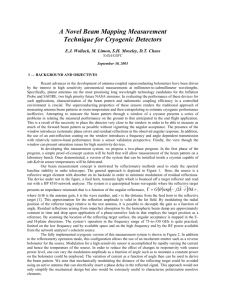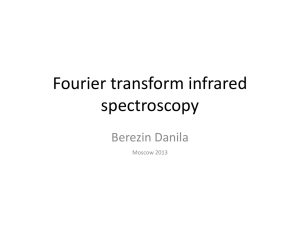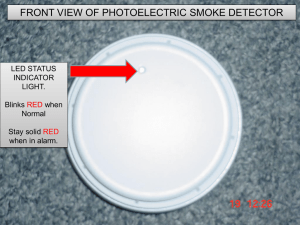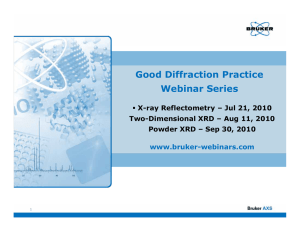Payne_Intro_Methods
advertisement
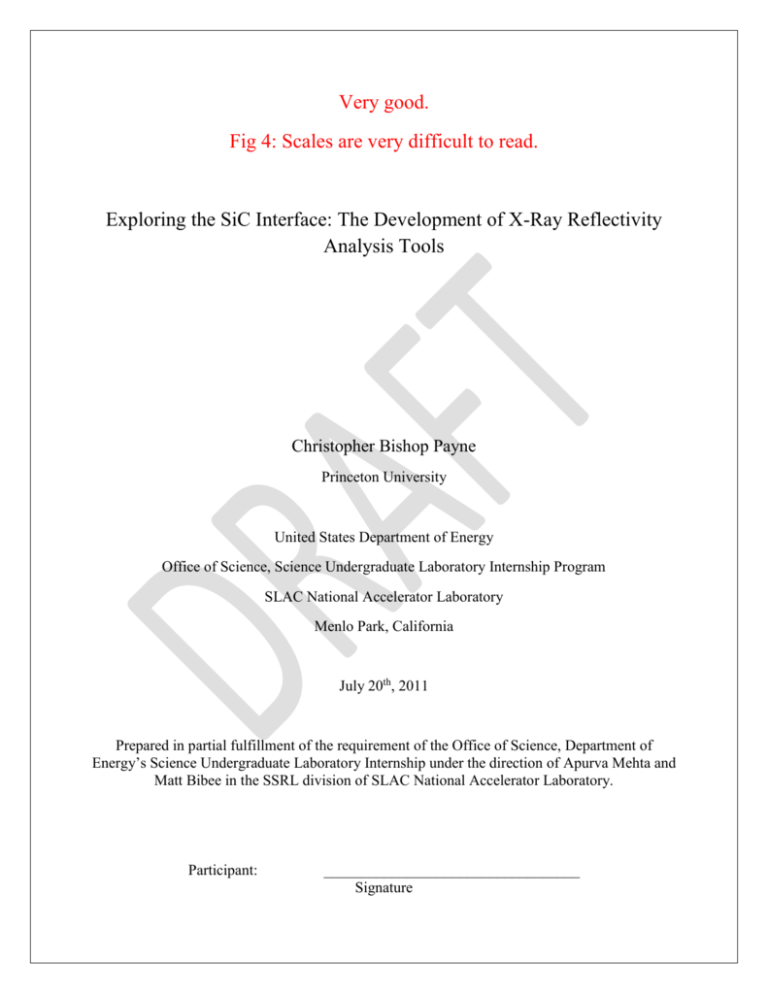
Very good. Fig 4: Scales are very difficult to read. Exploring the SiC Interface: The Development of X-Ray Reflectivity Analysis Tools Christopher Bishop Payne Princeton University United States Department of Energy Office of Science, Science Undergraduate Laboratory Internship Program SLAC National Accelerator Laboratory Menlo Park, California July 20th, 2011 Prepared in partial fulfillment of the requirement of the Office of Science, Department of Energy’s Science Undergraduate Laboratory Internship under the direction of Apurva Mehta and Matt Bibee in the SSRL division of SLAC National Accelerator Laboratory. Participant: __________________________________ Signature Research Advisors: __________________________________ Signature I. Introduction One of the main challenges to the development of increasingly sophisticated electronics in today’s world is the amount of energy such advanced applications demand. This problem is especially exacerbated by the fact that the electronic devices of tomorrow will be smaller and thus must use portable power sources such as batteries in a progressively more efficient manner. Lastly, this problem of energy consumption is set against the backdrop of a world that environmentally speaking cannot accommodate any significant increase in traditional energy demand. General Electric is exploring using silicon carbide(SiC) semiconductors in its future electronic products, a material whose favorable electrical characteristics would make it an efficient backbone for the electronics of tomorrow to be built upon. One hurdle standing in the way of this notable goal is that not enough is understood about the how the silicon oxide (SiO2)1 layer interfaces with the SiC substrate it must be grown on in order to manufacture a properly operating device. Preliminary X-Ray Reflectivity(XRR) experiments conducted at the Stanford Synchrotron Radiation Lightsource (SSRL) by my mentor suggested the existence of an interfacial layer on the order of a few nanometers thick between the SiO2 and SiC substrate (See Figure 1) 2. If this interfacial layer is confirmed, it will be an important step in understanding how surface layers on the SiC Figure 1: The thin Si2CO2 layer represents the proposed interfacial layer 1 2 SiC Motivation YGao 3-27-2011 Final.pdf Figure taken from: Synchrotron X-ray Reflectivity Measurements of SiO2-SiC: Preliminary Analysis. Bibee, Mehta, and Pianetta. May 2011 substrate contribute to the electrical properties of the semiconductor, a relationship that is not understood by the SiC community at this time3 This summer, we will perform a repeat of the preliminary experiment with some additional modifications so that we can hypothesize the existence of this layer to a greater degree of precision. My direct role in this project, in addition to executing some of the XRR experiments will be to develop MATLAB analysis tools which will allow us to better match our data to simulation generated data. The hope is that I can quantitatively match data to model rather than using the current process of ‘eye-balling’ which simulation looks closest to the data set. II. Methods And Materials In order to fully appreciate and understand the components of this project we must first establish the theory behind the XRR measurements that will be taken on Beam Line 2-1 at SSRL during this experiment. XRR is a well established technique in which a sample is illuminated by an xray beam and the reflectivity of the sample is measured for various values of theta (See Figure 2), typically ranging from zero to eight degrees. Incident Xray Detector Reflected Signal ϴ Figure 2 Sample When the sample is struck in this low theta range, the corresponding reflectivity signal contains information about the electron density of the surface of the sample.4 Gradients in this electron density data are correlated with different layers of material existing on the surface of the sample and thus we are able to detect surface layers on the order of [10 nm(need to confirm)]. 3 4 Xray Reflectivity Exp-2 6-15-2011 Toney&Brennan1989_CarbonThinFilmXRR.pdf One theory that models this correlation is Diffraction Theory, I will present an abbreviated explanation of this theory in the following. If we take the simplest scenario in which two point atoms are struck with an incident x-ray beam and reflect at the same angle theta from the incident beam, the detector will receive the same reflected beam, except one will have traveled an extra distance denoted by the red line (See Figure 3). Detector Figure 3 Reflected Beam ϴ Distance ‘d’ Incident Beam ϴ Mathematically this is equivalent to 𝐸𝑥𝑡𝑟𝑎 𝐷𝑖𝑠𝑡𝑎𝑛𝑐𝑒 = 𝑑sin(𝜃) This extra distance will then correspond to a phase difference at the point that the reflected beams interfere at the detector, dependent on the wavelength(𝜆) of the incident beam: 𝑃ℎ𝑎𝑠𝑒 𝐷𝑖𝑓𝑓𝑒𝑟𝑒𝑛𝑐𝑒 𝐴𝑡 𝐷𝑒𝑡𝑒𝑐𝑡𝑜𝑟 = 𝑑sin(𝜃) 𝜆 We can imagine increasing the number of point atoms to n atoms and summing the corresponding n reflected beams at the detector making sure to account for their phase differences. We also must introduce the concept that the amplitude of the reflected beam is modulated by a factor dependent on the value of ‘d’, we will denote this factor as f(d). Employing Euler formulism, we now can describe the sum of the reflected beams that the detector sees as: 𝑆𝑢𝑚 𝑜𝑓 𝑟𝑒𝑓𝑙𝑒𝑐𝑡𝑒𝑑 𝑏𝑒𝑎𝑚𝑠 𝑎𝑡 𝑑𝑒𝑡𝑒𝑐𝑡𝑜𝑟 = 𝐼𝑛𝑡𝑒𝑛𝑠𝑖𝑡𝑦 = ∑ 𝑓(𝑑)𝑒 𝑖2𝜋 𝑑sin(𝜃) 𝜆 Thus the intensity signal the detector sees is the Fourier transform of the distance between the two point atoms. Transforming a real space measurement such as distance results in a measurement in reciprocal space, thus the intensity reveals information about the reciprocal space of the structure the incident beam strikes. The useful information for us lies in the real space region, thus we must take the Fourier transform(FT) of the intensity signal 5: 𝐼𝑛𝑡𝑒𝑛𝑠𝑖𝑡𝑦 = 𝐹𝑇(𝑅𝑒𝑎𝑙 𝑆𝑝𝑎𝑐𝑒) 𝐹𝑇(𝐼𝑛𝑡𝑒𝑛𝑠𝑖𝑡𝑦) ≈ 𝑅𝑒𝑎𝑙 𝑆𝑝𝑎𝑐𝑒 In summary, we need to take the Fourier transform of the intensity signal at the detector in order to uncover the real space thicknesses of layers on the surface of the sample. ___ As an added complication, the intensity data does not appear as a simple sine wave in the reciprocal domain that can be transformed into a clear impulse in the real space domain corresponding to a finite layer thickness. Rather, the intensity signal is mixed in with an exponential drop off curve that falls over 8 orders of magnitude over the theta domain: Figure 4 5 Interpreting Reciprocal Space-peaks. Apurva Mehta. Looking at Figure 4, the first plot is of the raw data the detector records, plotted in log scale. The second plot is an approximation of the oscillation data locked inside the raw detector data. The third plot is the Fourier transformation of this oscillation data, which has a steep peak at 25 nm, indicating a layer of this thickness is present on the sample. The programming component of my task is to find the best way to extract the oscillation present in the first plot so that the Fourier transform will exhibit clear impulses revealing the different layer thicknesses on the substrate. Once I have finished the development stage of this ‘oscillation extraction’ algorithm, I will apply it to the data we are presently collecting with the hopes of confirming the hypothesis that a very thin layer exists upon the SiC substrate. This algorithm is so crucial because to date, my mentor does not have a such an ‘oscillation extraction’ algorithm and thus must do everything by hand. END OF DRAFT Short outline of my project: 1. Develop ‘oscillation extraction algorithm’(s) (Done) a. Decide on the ‘best’ one by comparing its results to simulation data(In Progress) 2. Run XRR experiment(In Progress) 3. Analyze my XRR data in search for this thin layer.(Awaiting completion of 1 and 2)

